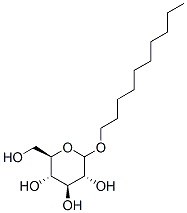Decyl glucoside
- CAS NO.:68515-73-1
- Empirical Formula: C16H32O6
- Molecular Weight: 320.22
- MDL number: MFCD23103077
- EINECS: 500-220-1
- SAFETY DATA SHEET (SDS)
- Update Date: 2024-12-18 14:08:57

What is Decyl glucoside?
The Uses of Decyl glucoside
Triton??CG-110 can be used:
- In the preparation of multilamellar vesicles as carriers for tretinoins and retinoids.
- In the study of mineralization, leaching, and adsorption of glyphosate herbicide in the soil.
The Uses of Decyl glucoside
Decyl Glucoside is a nonionic surfactant used as a foamer, detergent, conditioner or emulsifier. It can be used as a base surfactant or co-surfactant in detergents. It has excellent foaming ability and good skin compatibility. It can be combined with other glucosides using to enhance foaming and skin conditioning properties. It can also be utilised in ionic formulations in order to increase foam depth and emulsification properties. Commonly used in shampoos and body washes.
General Description
This product is a biodegradable surfactant and is aligned with the 10th principle of Green Chemistry "Design for Degradation".
Contact allergens
Decyl glucoside or decyl d-glucoside, also named decylbeta- d-glucopyranoside, belongs to the alkyl glucosides family and is obtained by condensation of the fatty alcohol decyl alcohol and a d-glucose polymer. This nonionic surfactant and cleansing agent has been widely used for several years, due to its foaming power and good tolerance in rinse-off products such as shampoos, hair dyes and colors, and soaps. Decyl glucoside is also employed in leave-on products such as no-rinsing cleansing milks, lotions, and several sunscreen agents and is contained as a stabilizing surfactant of organic microparticles in sunscreen agent Tinosorb? M.
Side Effects
The Cosmetic Ingredient Review expert panel, or the CIR, deemed Decyl glucoside is completely safe for use, amongst its assessment of nineteen other alkyl glucosides. However, in rare cases, when the individual is hypersensitive towards decyl glucoside, there could be irritation, redness, itching, or burning on the skin. In some cases, this results in contact dermatitis, when the individual has type-4 hypersensitivity to decyl glucoside.
Synthesis
Decyl glucosides (DGs) were prepared from D-glucose with 1-decanol by direct glucosidation over the zeolite catalysts. D-glucose (2.5 g) and 1-decanol (50 mL) were introduced as the reactants. The reactants were put into the reactor with the zeolite catalyst. The reaction was carried out directly in the reactor, stirring at 130 ℃[1].
References
[1] Kyong-Hwan Chung. “Decyl Glucoside Synthesized by Direct Glucosidation of D-Glucose Over Zeolite Catalysts and Its Estrogenicity as Non-Endocrine Disruptive Surfactant.” Journal of nanoscience and nanotechnology 19 2 (2019): 1172–1175.
Properties of Decyl glucoside
| Density | 1.15 g/mL at 20 °C |
| form | liquid |
| InChI | InChI=1/C16H32O6/c1-2-3-4-5-6-7-8-9-10-21-16-15(20)14(19)13(18)12(11-17)22-16/h12-20H,2-11H2,1H3/t12-,13-,14+,15-,16?/s3 |
| EPA Substance Registry System | Oligomeric D-glucopyranose decyl octyl glycosides (68515-73-1) |
Safety information for Decyl glucoside
| Signal word | Danger |
| Pictogram(s) |
 Corrosion Corrosives GHS05 |
| GHS Hazard Statements |
H315:Skin corrosion/irritation H318:Serious eye damage/eye irritation |
| Precautionary Statement Codes |
P264:Wash hands thoroughly after handling. P264:Wash skin thouroughly after handling. P280:Wear protective gloves/protective clothing/eye protection/face protection. P302+P352:IF ON SKIN: wash with plenty of soap and water. P305+P351+P338:IF IN EYES: Rinse cautiously with water for several minutes. Remove contact lenses, if present and easy to do. Continuerinsing. P332+P313:IF SKIN irritation occurs: Get medical advice/attention. |
Computed Descriptors for Decyl glucoside
| InChIKey | JDRSMPFHFNXQRB-TVHDANIINA-N |
| SMILES | O(CCCCCCCCCC)C1O[C@H](CO)[C@@H](O)[C@H](O)[C@H]1O |&1:13,16,18,20,r| |
New Products
(S)-3-Aminobutanenitrile hydrochloride 4-Methylphenylacetic acid N-Boc-D-alaninol N-BOC-D/L-ALANINOL Tert-butyl bis(2-chloroethyl)carbamate 3-Morpholino-1-(4-nitrophenyl)-5,6-dihydropyridin- 2(1H)-one Furan-2,5-Dicarboxylic Acid Tropic acid 1-Bromo-3,5-Di-Tert-Butylbenzene S-2-CHLORO PROPIONIC ACID ETHYL ISOCYANOACETATE 2-Bromo-1,3-Bis(Dimethylamino)Trimethinium Hexafluorophosphate 4-IODO BENZOIC ACID 3-NITRO-2-METHYL ANILINE 1-(2,4-DICHLOROPHENYL) ETHANAMINE (2-Hydroxyphenyl)acetonitrile 4-Bromopyrazole 2-(Cyanocyclohexyl)acetic acid 4-methoxy-3,5-dinitropyridine 1-(4-(aminomethyl)benzyl)urea hydrochloride 2-aminopropyl benzoate hydrochloride diethyl 2-(2-((tertbutoxycarbonyl)amino) ethyl)malonate tert-butyl 4- (ureidomethyl)benzylcarbamate Ethyl-2-chloro((4-methoxyphenyl)hydrazono)acetateRelated products of tetrahydrofuran








You may like
-
 Triton™ CG-110 CAS 68515-73-1View Details
Triton™ CG-110 CAS 68515-73-1View Details
68515-73-1 -
 2033-24-1 98%View Details
2033-24-1 98%View Details
2033-24-1 -
 1975-50-4 98%View Details
1975-50-4 98%View Details
1975-50-4 -
 2-HYDROXY BENZYL ALCOHOL 98%View Details
2-HYDROXY BENZYL ALCOHOL 98%View Details
90-01-7 -
 2-Chloro-1,3-Bis(Dimethylamino)Trimethinium Hexafluorophosphate 221615-75-4 98%View Details
2-Chloro-1,3-Bis(Dimethylamino)Trimethinium Hexafluorophosphate 221615-75-4 98%View Details
221615-75-4 -
 61397-56-6 CIS BROMO BENZOATE 98%View Details
61397-56-6 CIS BROMO BENZOATE 98%View Details
61397-56-6 -
 14714-50-2 (2-Hydroxyphenyl)acetonitrile 98+View Details
14714-50-2 (2-Hydroxyphenyl)acetonitrile 98+View Details
14714-50-2 -
 118753-70-1 98+View Details
118753-70-1 98+View Details
118753-70-1